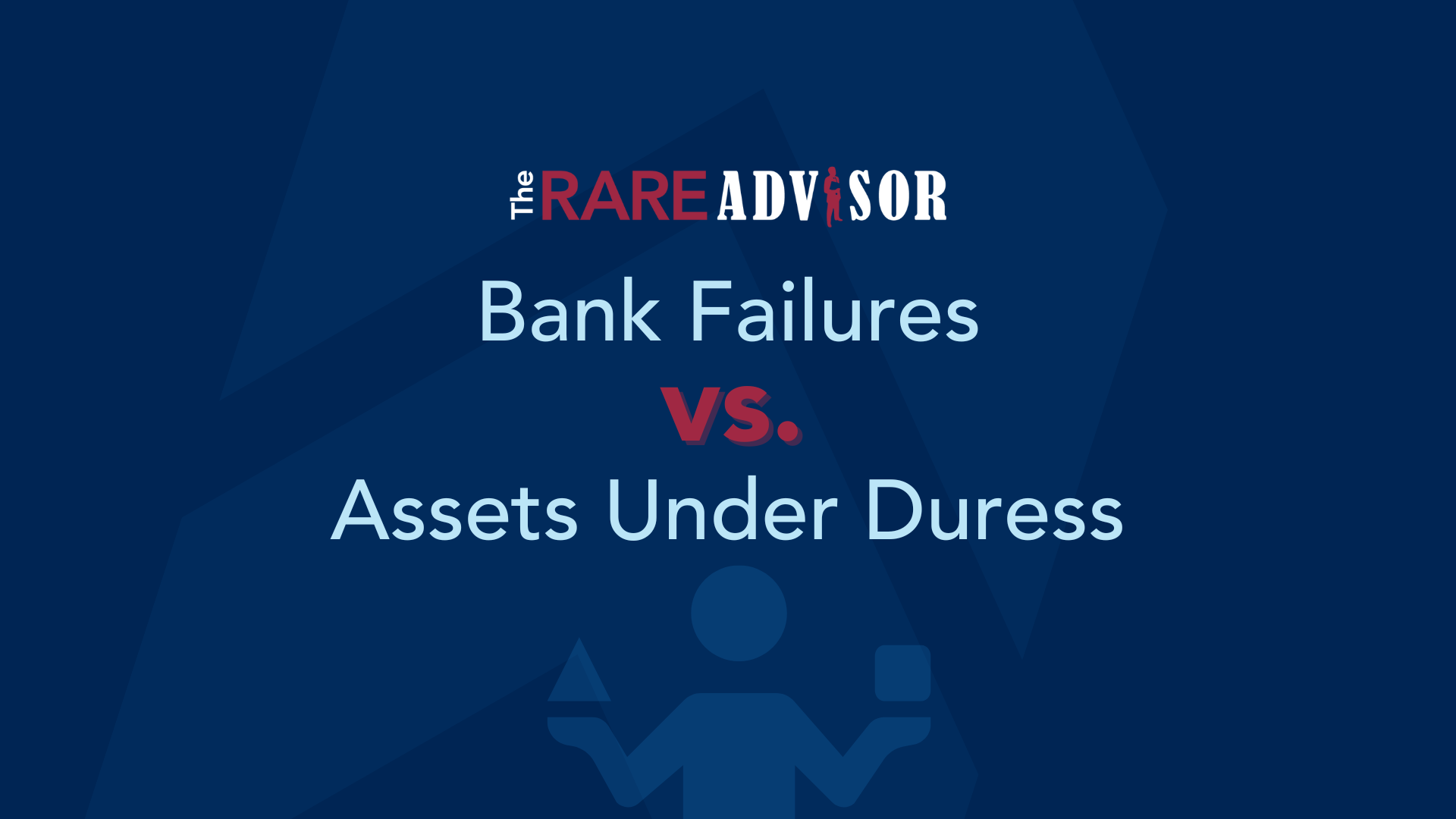The RARE Advisor: Comparing the Bank Failure to Assets Under Duress Ratio

Some people are concerned about the recent bank failures, and others not so much. But, candidly, they’re both right. In this episode of The RARE Advisor we’ll take a deeper dive into the bank failure vs. assets under duress ratio and what that means in the grander scheme of things.
Some people are freaking out about the mid-size bank crisis (as it's been referred to). And other people are like "well, what's the worry? It's really only three banks. I mean, think back to the financial crisis and what we were dealing with then." Well, candidly, they're both right.
What I'm sharing with you today are two different charts that help bring that into perspective and give you a little bit of an insider scoop view of really where this stuff kind of shakes out, numerically.
The first chart is showing you total assets and total bank failures. The green is total assets, which was capping out in 2008 at 400,000 (Millions). In red, the number of bank failures capped out in 2010 at a high of 157 (in terms of its its annual numeric), and then you see it all kind of dropped back down. Then all the sudden the green line jumps up again in 2022. Now we're at 548,500 (Millions). But the flip side is down in the red - we're only looking at three banks. So on the one hand, it was just three banks. On the other hand, it was more assets than was under duress during the financial crisis. Now, this is actual straight line numerics. Even if you put an inflation trigger in there, you're still seeing a pretty significant jump.
What I want also want to show you is a bubble chart that this gentleman created, where the bubble is the size of the bank in terms of its assets, and then the number of bubbles is the number of bank failures. There is a big jump up just like we saw on the other chart, and then it runs back down. And then as you can see, look at all these hundreds of banks in here. But really the big one was Washington Mutual, all the rest of them are quite a bit smaller.
And then we come out to what has been taking place recently. You can see the jump on the assets. But there's only three banks: Signature Bank, Silicon Valley Bank, and First Republic Bank. So again, it's only three banks. They weren't the huge players in the market, but numerically in comparison to previous bank failures, they were pretty significant. Hopefully that doesn't catch and start running amok with more banks, but the number of assets was higher than probably you would have guessed.
--
The RARE Advisor is a business model supercharged by Recurring And Repeatable Events. With more than thirty years of working with and coaching successful advisors, host Mike Walters (along with other leaders in the industry), discusses what it takes to grow a successful practice. With the aim of helping financial professionals and financial advisors take their business to the next level, Mike Walters shares insights and success stories that make a real impact. Regardless of the stage of your practice, The RARE Advisor will provide thoughtful guidance, suggestions for developing systems and processes that work, and ideas for creating an authentic experience for your clients.
The RARE Advisor is also a podcast! Subscribe today via Apple Podcasts, Google Podcasts, or your preferred podcast listening service for easier on-the-go listening.
Author Info

Mike Walters is the Chief Executive Officer (CEO) of USA Financial, leading the firm since its inception in 1988. Mike is committed to...
Related Posts

How to Survive (and Thrive) When the Market Dips
The S&P 500 is down nearly 9% from its yearly high. So, what does that mean for you? In this March episode of the Trending Report, we'll delve into the necessity of planning for volatility, not just market growth, and highlight the value of experienced advisors who employ formulaic, unemotional strategies. While short-term trends are currently negative, long-term perspectives remain positive, reinforcing the idea that market cycles are normal.

What’s Trending: Navigating Volatility in Times of Uncertainty
In this episode of the Trending Report, we’ll examine key indicators like the CBOE Volatility Index (VIX) and the Consumer Confidence Index. We emphasize the importance of maintaining emotional discipline when investing and highlight how risk management strategies can effectively navigate market fluctuations, plus also underscore the significance of long-term investment goals and the importance of setting realistic return expectations.

What’s Trending: Is Your Portfolio Ready for 2025?
Following a strong market performance in 2024, you may be wondering what’s ahead in 2025 – especially after market performance the first couple weeks of the new year. In this edition of the Trending Report, we discuss the critical importance of maintaining an unemotional investment strategy. We'll explore why reacting to short-term market swings can hurt your long-term goals and provide practical tips for staying disciplined and focused on your financial plan - especially during times of change and uncertainty.

How to Survive (and Thrive) When the Market Dips
The S&P 500 is down nearly 9% from its yearly high. So, what does that mean for you? In this March episode of the Trending Report, we'll delve into the necessity of planning for volatility, not just market growth, and highlight the value of experienced advisors who employ formulaic, unemotional strategies. While short-term trends are currently negative, long-term perspectives remain positive, reinforcing the idea that market cycles are normal.

What’s Trending: Navigating Volatility in Times of Uncertainty
In this episode of the Trending Report, we’ll examine key indicators like the CBOE Volatility Index (VIX) and the Consumer Confidence Index. We emphasize the importance of maintaining emotional discipline when investing and highlight how risk management strategies can effectively navigate market fluctuations, plus also underscore the significance of long-term investment goals and the importance of setting realistic return expectations.

What’s Trending: Is Your Portfolio Ready for 2025?
Following a strong market performance in 2024, you may be wondering what’s ahead in 2025 – especially after market performance the first couple weeks of the new year. In this edition of the Trending Report, we discuss the critical importance of maintaining an unemotional investment strategy. We'll explore why reacting to short-term market swings can hurt your long-term goals and provide practical tips for staying disciplined and focused on your financial plan - especially during times of change and uncertainty.

